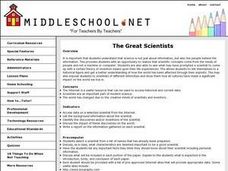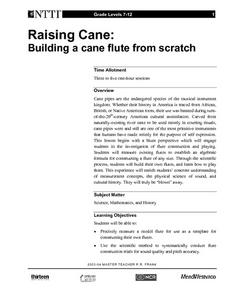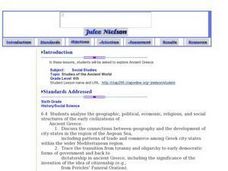Curated OER
Johannes Kepler
In this online interactive history worksheet, learners respond to 10 short answer and essay questions about the achievements of Johannes Kepler. Students may check some of their answers on the interactive worksheet.
Curated OER
Groundwater Flow Demonstration Model
Students investigate the concept of groundwater that includes aquifers, groundwater flow, and the water table. They participate in activities using a flow demonstration model. Its use engages all types of learners because of its hands on...
Curated OER
History of Blood Transfusions
Eighth graders use the Internet to research the important people in history of blood transfusions. In this blood transfusions lesson students prepare and present an oral presentation of their research.
Curated OER
The Great Scientists
Young scholars discuss the characteristics of competent scientists. By researching selected scientists on the Internet, they gather and organize collected information into a cohesive paper.
Curated OER
Just How Small is a Nanoparticle?
Students determine the size of a nanoparticle. In small groups, they calculate the actual size of a particle shown in a photo, and discuss how they arrived at their answers.
Curated OER
A Picture Is Worth A Thousand Words
Learners examine the cultural and historical significance of certain artists. They use the internet to perform research and prepare a report of analysis of artistic works looking for cultural influences. Students also tie in the...
Curated OER
Myth of the Western Man
Learners identify ways in which history and culture influence identity. They make a time-line and research dates to identify their significance, as well as, create a self portrait pictorially or verbally, that explores the complexity of...
Curated OER
Measuring Vibration of Energy
In this chemistry learning exercise, students measure the different vibration levels of energy. They use the fundamental vibration frequency formula to calculate the Morse potential for a given chemical bond. There are 2 questions.
Curated OER
Heat Transfer and Pollution
Pupils perform computer simulations on air dispersion. In this chemistry lesson plan, students calculate energy transfer based on specific heat and temperature change. They explain the causes of smog.
Curated OER
Acid Rain
Students write paragraphs and color illustrations about acid rain. They color in where gases come from, where they mix, and where they return. They discuss where acids form in the atmosphere and list manmade sources of gases.
Curated OER
Biology: Howler Monkeys Tell All
Students examine a PBS special about howler monkeys as an introduction to scientific forensic investigative methods. In groups, they conduct a host of experiments containing clues which point to discovery. By challenging assumptions,...
NTTI
Vectors: Traveling, But in What Direction
High schoolers watch a video of real-world situations regarding speed, direction, velocity, force, etc. and answer questions while viewing. They then practice drawing and using vectors to solve more real-world problems.
Curated OER
Vectors: How Much Force Can You Apply
This lesson entails the viewing of two videos to get an overview of force and its application. The lesson covers how vectors use force in real-world situations.
Curated OER
Family Activity: Gift Wrapping - Surface Area
In this surface area worksheet, students solve 6 short answer problems. Students determine the amount of gift wrap paper needed to cover a rectangular box using surface area formulas.
Curated OER
Physiology of Reproduction
In this health worksheet, young scholars examine the human body and make mental connections to the target function highlighted in the sheet.
Curated OER
GANDHI'S INDIA
Students describe key events in the life of Gandhi. They determine why knowledge of geography is necessary to understand the history of the people in a place or region. They write a summary of how the events in Gandhi's life,...
Curated OER
THEMIS: A Magnetic Case of 'What Came First?'
In this magnetic reconnection worksheet, students solve seven problems using the data and graphs from the THEMIS satellite constellations, which show a series of events triggered by a magnetic reconnection. Students interpret the data in...
Curated OER
Developing the Concept Division
Students use manipulatives to explain the concept of dividing multi-digit numbers.
Curated OER
Rome: Republic to Empire
Sixth graders discuss the rise of Rome from a republic to a dictatorship. In small groups, they role-play as congress people debating whether or not to give the president more powers. In another activity, 6th graders produce television...
Curated OER
Political Traditions
Students compare and contrast the political institutions in Greece, Rome, and the United States. In groups, they take this information to determine the influences on James Madison when organizing the republic. They develop a chart and...
Curated OER
George Mason and the Constitution
Pupils read various articles about the political beliefs of George Mason. In groups, they describe the major events of his life that formed his beliefs and values. They also analyze his contributions to the Constitution and the Bill of...
Curated OER
Raising Cane: Building a Cane Flute From Scratch
Eighth graders create their own cane flute. They use a model flute to gain the correct measurements and use the scientific method to construct the flute to have sound quality and pitch accuracy.
Curated OER
Studies of the Ancient World
Sixth graders, after taking a pretest, write a paragraph describing the difference between Athens and Sparta and write an article about the ancient Phoenicians, describing their contributions to world history. They compare democracy in...
Curated OER
Turn of the Century
Young scholars explore the transformation of America's economy in response to the Industrial Revolution in terms of patterns of agricultural and industrial development relating to climate, natural resource use, markets and trade.























